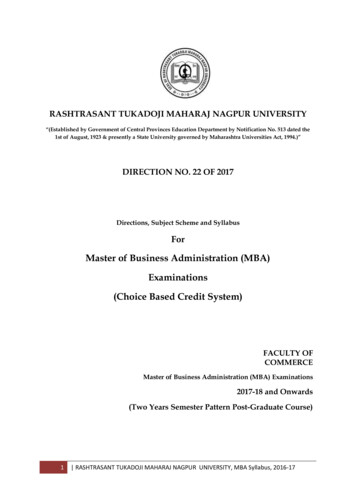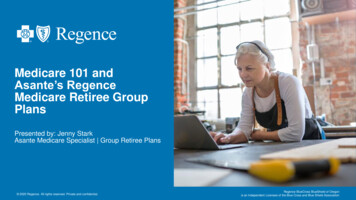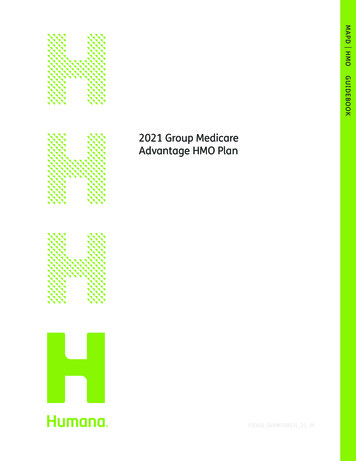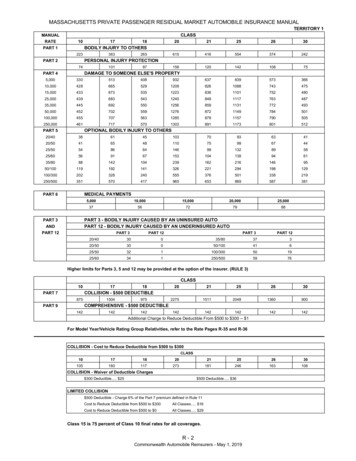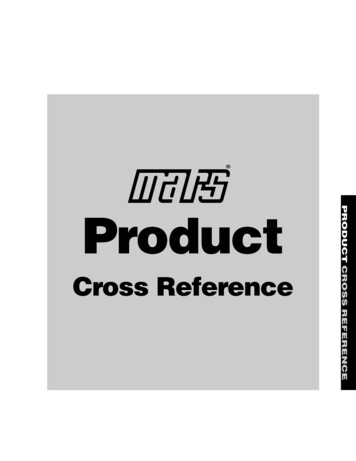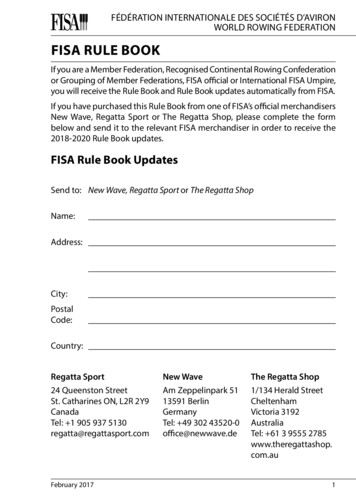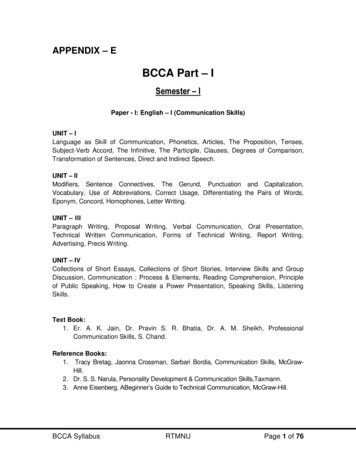
Transcription
APPENDIX – EBCCA Part – ISemester – IPaper - I: English – I (Communication Skills)UNIT – ILanguage as Skill of Communication, Phonetics, Articles, The Proposition, Tenses,Subject-Verb Accord, The Infinitive, The Participle, Clauses, Degrees of Comparison,Transformation of Sentences, Direct and Indirect Speech.UNIT – IIModifiers, Sentence Connectives, The Gerund, Punctuation and Capitalization,Vocabulary, Use of Abbreviations, Correct Usage, Differentiating the Pairs of Words,Eponym, Concord, Homophones, Letter Writing.UNIT – IIIParagraph Writing, Proposal Writing, Verbal Communication, Oral Presentation,Technical Written Communication, Forms of Technical Writing, Report Writing,Advertising, Precis Writing.UNIT – IVCollections of Short Essays, Collections of Short Stories, Interview Skills and GroupDiscussion, Communication : Process & Elements, Reading Comprehension, Principleof Public Speaking, How to Create a Power Presentation, Speaking Skills, ListeningSkills.Text Book:1. Er. A. K. Jain, Dr. Pravin S. R. Bhatia, Dr. A. M. Sheikh, ProfessionalCommunication Skills, S. Chand.Reference Books:1. Tracy Bretag, Jaonna Crossman, Sarbari Bordia, Communication Skills, McGrawHill.2. Dr. S. S. Narula, Personality Development & Communication Skills,Taxmann.3. Anne Eisenberg, ABeginner‘s Guide to Technical Communication, McGraw-Hill.BCCA SyllabusRTMNUPage 1 of 76
Paper - II: Financial AccountingUNIT – IIntroduction to Financial Accounting: Accounting as an information system, Financial,cost and management Accounting and their interrelationships, Finance Function andAccounting, Accounting as an academic Discipline, Accounting as an Career andProfession, Place of Accounting Officers in the Organization, Auditing and InternalControl, Ethical Issues in Accounting, Forms of Organizations and Their Effect onAccounting, Accounting and Corporate Governance. Accounting Concepts, Standardsand IFRS: Introduction ,Accounting Concepts and Convention, Accounting Policies,Generally Accepted Accounting Principles(GAAP), International Financial ReportingStandards(IFRS),Indian Accounting Standards(Ind AS),India‘s Road map toConvergence with IFRS, Indian Government Accounting Standards(IGAS).Presentation of Financial Statements: Balance Sheet: Conceptual Basis of a BalanceSheet, Capital and Revenue Expenditure and receipts, Classification of Item on aBalance sheet, Format of Balance Sheet, Balance Sheet Equation, Preparing BalanceSheet.UNIT – IIPreparation of final Accounts: The Income Statements: Introduction, Format of Profitand Loss Account, Profit and Loss account of a Manufacturing Concern, Appropriation ofProfit, Advantages of Profit and Loss Account. Mechanics of Accounting: Introduction,Classification of Accounts, Double Entry System, Overview of Accounting cycle,Preparing journals, Subsidiary Books, Ledger, Preparation of Trial Balance, AccountingErrors and Their Rectification, Bank Reconciliation statement (BRS), ComputerisedAccounting. Fixed Assets and Depreciation Accounting: Introduction, Cost of FixedAssets, Depreciation, Method of computing depreciation, Accounting Treatments fortransactions, Impairment of Assets.UNIT – IIIInventory Valuation: Introduction, Record Keeping for Inventory, Perpetual inventorySystem, Inventory Valuation/Measurement, Methods of Valuation of Inventories,Analysis of Inventories. Corporate Accounts: Introduction to Companies, Types ofCompanies, Shares and Share Capital, Issue of Shares. Share Issue: Payments inInstallment, Buyback of Shares, Debentures and Bonds, Income Statement/Profit andLoss Account, Balance Sheet, Company Annual Report. Cash Flow Statement:Introduction to Cash Flow Statement, Cash and Cash Equivalents, Cash Flow Activities,Operating Activities, Some Special Items, Free cash Flow, Fund Flow Statement,Analysis of cash Flow Statement, Preparation of cash Flow Statement.UNIT – IVFinancial Statement Analysis: Introduction Techniques for financial StatementAnalysis Horizontal Analysis: Comparative and Trend Statements, Vertical Analysis:Common Size, Liquidity Ratios: Current and Quick Ratio, Solvency Ratios: D/E, InterestCoverage, Profitability ratios: (GP,NP,EBIT,EBDITA,EPS), Return Ratios: ROI, ROE,Turnover Ratios, Analysis of Stock and Debtors, Working Capital Management, StockPrices and Financial Data: P/E. Investments: Introduction, Financial Instruments,Assets and Liabilities, Joint Ventures, Subsidiaries and Associates, ConsolidatedFinancial Statement, Business Combinations, Accounting for Investments,Contemporary Issues in Accounting : Introduction ,Foreign Currency Accounting ,Creative Accounting, Forensic Accounting , Environmental Accounting, Lean Accounting,Human Resource Accounting, Objectives of Human resource Accounting, HRA in India,Inflation Accounting, Responsibility Accounting, Transfer Pricing, Segment reporting,Extensible business Reporting Language(XBRL).BCCA SyllabusRTMNUPage 2 of 76
Text Book:1. Varadraj Bapat, Mehul Raithatha, Financial Accounting, McGraw-Hill.Reference Books:1. M.N. Arora, K.V.Achalapati, S.Brinda, Finiancial Accounting, Taxmann2. M. Hanif, A. Mukherjee, Financial Accounting, McGraw-Hill.3. N. Ramachandran, Ram Kumar Kakani, Financial Accounting for management,McGraw-Hill.4. Dhanesh K Khatri, Accounting for Management, McGraw-Hill.BCCA SyllabusRTMNUPage 3 of 76
Paper - III: Fundamentals of ComputerUNIT – IUnderstanding the Computer: Introduction, Evolution of computers, Generation ofcomputers, Classification of computers, Computing concepts, The computer system,Application of computers. Computer Organization and Architecture: Introduction,Central processing unit, Internal communications, Machine cycle, The bus, Instructionset. Memory and Storage Systems: Introduction, Memory representation, RandomAccess Memory, Read Only Memory, Storage systems, Magnetic storage systems,Optical storage systems, Magneto optical system, Solid-state storage devices, storageevaluation criteria.UNIT – IIInput Devices: Introduction, Keyboard, Pointing devices, Scanning devices, Opticalrecognition devices, Digital camera, Voice recognition system, Data acquisition sensors,Media input devices. Output Devices: Introduction, Display monitors, Printers, Impactprinters, Non-impact printers, Plotters, Voice output systems, Projectors, Terminals.Computer Codes: Introduction, Decimal system, Binary system, Hexadecimal system,Octal system, 4-bit Binary Coded Decimal(BCD) Systems, 8-bit BCD Systems, 16-bitUnicode, Conversion of numbersUNIT – IIIComputer Software: Introduction, Types of computer software, System managementprograms, System development programs, standard application programs, Uniqueapplication programs, Problem solving, Structuring the logic, Using the computer.Programming Languages: Introduction, History of programming languages,Generations of programming languages, Characteristics of good programminglanguages, Categorization of High-level languages, Popular High-level languages,Factors affecting the choice of languages, Developing a program, Running a program.Data Communication and Networks: Introduction, Data communication using modem,Computer network, Network topologies, Network protocol and software, Application ofnetwork.UNIT – IVOperating Systems: Introduction, History of operating systems, Functions of operatingsystems, Process management, Memory management, File management, Devicemanagement, Security management, Types of operating systems, Providing userinterface, Popular operating systems. Microsoft Software: Introduction, MS-DOS, MSWord systems, MS Excel systems, MS PowerPoint systems, MS Access systems, MSPublisher,Text Book:1. E Balagurusamy, Fundamentals of Computers, Mc Graw Hill Education.Reference Books:1 . Dr. Rajiv Midha, S. Brinda, Fundamental of Information Technology, Taxmann.2 . Madhulika Jain, Shashank Jain, Satish Jain, Information Technology Concepts, BPBPublication.3 . Dr. Rajiv Midha, Information Technology, Taxmann4 . B. Ram, Computer Fundamentals (Architecture & organization), New Age InternationalPublisher.5. Turban, Rainer, Potter, Introduction to Information Technology, Wiley India Edition.6. Sanjay Saxsena, Introduction to Information Technology, Vikash Publishing House Pvt.Ltd.7. Dr. Sushila Madan, Information Technology, Taxmann.BCCA SyllabusRTMNUPage 4 of 76
Practical List of Fundamentals of Computer1. Insert a line chart with the following data. Specify Chart title as ―Yearly Income (InLakhs)‖.COUNTRIESGOLDDIAMONDIRON OREINDIAUSACHINAJAPAN5040456035405565603560702. Create a Table of Contents for Generations of Computers.3. Create the following result card in Ms-WordMount Carmel SchoolSector 46, Chandigarh.Class 9thRoll No. 123Student NameManinder RajFather‘s NameSh.S.S. ChauhanSubjectEnglishMathsScienceSocial StudiesHindiComputer ScienceTotalResult CardTerm-II ExaminationMax. Marks100100100100100100600Position in the Class: IIndRemarks: GoodParents SignatureMarks Obtained929398887890539Principal Signature4. Write all the options of standard and formatting toolbar. Use different types of bulletsand numbering. Divide the page in two columns.5. Using Mail merge, write a letter to all the selected candidate for their final interviewon 20th Sep 2008 at Dotcom Services Ltd, Nawab Layout, Nagpur 10 at 11:00 amalong with necessary documents, resume and 2 Passport size photographs.6. Create the following table by Insert Table option of MS WordBCCA SyllabusRTMNUPage 5 of 76
Population ChartCountryINDIAUSAUKYearPopulation 70199975200080TotalPopulationApply Auto format (Table web2) to the above table.Calculate Total Population by using formula ―SUM‖.7. Create your resume using Resume Wizard.(Using Templates)8. Write a Cotemporary letter regarding launch of newcompany.(Using Templates).9. Make a list of the following functions with example and syntax.i. Sumix. Upperii. Averagex. Loweriii. Maxxi. Todayiv. Minxii. Nowv. Countxiii. Romanvi. Roundxiv. Meanvii. Sqrtxv. Medianviii. ABSxvi. Modeproductina10. Calculate Profit and prepare a Column chart in MS Excel using the 02BCCA SyllabusNet Sales Total 0RTMNUProfit(Rs.Lakhs)Page 6 of 76
a) Give chart Title - Profit Reportb) X axis Title- Monthsc) Y axis Title- Amt(in Lakhs)11. Prepare billing report for M/s.Total Synergy Consultancy Private Limited (TSCPL) inMS Excel.Figures in ‗000ConsultantQtr 1Qtr 2Qtr3Qtr 4Yearly TotalR.Bhatnagar Rs9,752.00 Rs10,129.00 Rs8,212.00 Rs7,032.00M.LathRs5,755.00Rs6,477.00 Rs5,447.00 Rs4,584.00P.SharmaRs6,769.00Rs6,758.00 Rs6,378.00 Rs1,644.00K.PandeyRs3,708.00Rs5,795.00 Rs6,188.00 Rs1,636.00M.SwamyRs5,009.00Rs2,009.00 Rs7,643.00 Rs7,323.00Total Prepare Pie Chart showing consultant‘s contribution to Total yearly Billing from theabove example.12. Prepare a statement of Marks (Calculate the Total Marks, Average and Grade usingfunctions Sum, Average and IF).Criteria for Grade: Average 75 ----DistinctionAverage 60 ----FirstAverage 50 ----SecondAverage 45 ----Third13. Prepare the following table in a worksheet using 0190021001500GrossPayPFNetPayPerform the following calculations:a) Gross Pay Basic Pay DA HRAb) PF 12% of DAc) Net Pay Gross Pay- PFPerform the following formatting:a) Set column width 10b) Set row height 15c) Text Alignment:i. Horizontal : Centerii. Vertical : CentreBCCA SyllabusRTMNUPage 7 of 76
14. Prepare following table for ―DOTCOM SOLUTIONS LIMITED‖DOTCOM SOLUTIONS LIMITEDINVENTORY DATABASEINV.CODEDESCQTYRATEPRICEP1002TV-COLOUR 21"35 11000P1001TV-COLOUR 29"15 28000P1003DVD20 12000P1007STERIO536000P1008WASHING MACHINE21 18000P1005REFRIGERATOR408000P0004DISH WASHER5 20000P1009MIXER353000P1010GRINDER205000i) Calculate price and apply Auto format to the above table.ii) Sort the records in the table in ascending order of INV.CODE.15. Using conditional formatting on the above table perform the following :a) Highlight those INV.CODE values where INV.CODE is greater thanP1005.b) Highlight those quantity values where Qty is between 30 and 50.c) Highlight (Single Underline) the rate values where rate is less than 10000and (Bold) greater than or equal to 20000.d) Highlight (Strikethrough) the price value where price is equal to 3, 20,000and (Bold-Italic) not equal to 1, 00,000.16. Following data of DOTCOM SOLUTIONS LTD. is givenSalesRs.40, 00,000Variable costsRs.30, 00,000Fixed expensesRs.70, 000I.II.III.IV.Calculate:ContributionProfit Volume RatioBreak Even PointMargin of SafetyNOTE: Contribution sales – variable costPVR (contribution /sales) *100BEP (fixed cost / PVR)*100MOS Profit / PVR*100Profit contribution-fixed expense17. Use IF Functioni.From the data given below check whether the expenses are over budget orwithin budget using function IF.BCCA SyllabusRTMNUPage 8 of 76
ActualExpensesPredicted Expenses150090050090050092520001500Over/Within Budgetii. Design a mark sheet and enter record of any 5 students for three subject andcheck whether their result is PASS or FAIL using (IF-AND).Table structure should be as given:StudentMarksSr.NameNoSubject Subject2 Subject3 Result(PASS/FAIL)1Condition: result will be ―PASS‖ if marks of each subject are greater than 45.18. Enter the following data in 14,000300,00021,000400,00028,000From the above data calculate the following using function SUMIF Sum of the commissions for property values over 160,000 Sum of the commissions for property values below 300,000. Sum of the commissions for property values over 100,00019. Create Timetable by inserting table in Power Point.20. Using the following data create a chart in power Point.Sub 1Sub 2Sub 3John565660Rita456780Joseph 566789Sub 46745789. Create a Power Point presentation using Auto Content Wizard.10. Create a PowerPoint presentation showing various features of MS Office.Demonstrate the use of master slide.11. Create a Power Point presentation listing various design templates available. Usevarious types of bullets and numbering. Each slide should have Animation effect.12. Create a Power Point Presentation for explaining various network topologies.13. Create an advertisement in Power Point with maximum 6 slides. Each slideshould have custom animation.BCCA SyllabusRTMNUPage 9 of 76
14. Create a table EmpMaster in MS-ACCESS with following details:Field NameData Type DescriptionEmp IdTextSize 15, Input Mask: ###-##-###Emp NameTextSize 20, Format: (Display in Uppercase)AddressTextSize 30Joining dateDateFormat ‖Short date‖, Validation rule Employee joined between 01/01/07 and date()MarriedYes/NoNo of Children NumberValidation Rule : not more than 2 ( 2)a) Set Emp Id as Primary key. b) Insert information about 10 Employees.c) Use column width as best fit.d) Print the table design view and datasheet view.15. Create a table BookDetails in MS-ACCESS with following details:Field NameData Type DescriptionBook IdTextSize 3 , Like Eg: B101TitleTextSize 20, Format: (Display in lowercase)AuthorTextSize 20, Format: (display in uppercase)PublicationTextSize 30Edition NoNumberFormat BytePriceCurrencyUse Currency Symbol Rs.PagesNumberFormat Bytea) Set Book Id as Primary key. b) Insert information about 10 Books.c) Use column width as best fit.d) Print the table design view and datasheet view.16. Consider the following table and perform the operation given below:ProductDetailsProd Id Prod NameCompany NameCountry101ChavanprashDabur LtdIndia121ChocolatesAmul LtdIndia126Face washAmway LtdUSA163SoapHindustan Lever LtdIndia132Cold CreamNivea LtdGermany135Hair GelL‘Oreal Pvt LtdAustralia111DeodorantCoty IncorporationSouth Africa106Hair ShampooAmway LtdUSAa) Select only those records whose country ―India‖b) Select only those record whose company ―Amway Ltd‖c) Print the table datasheet view of both a) and b) after selection.BCCA SyllabusRTMNUPage 10 of 76
17. Consider the followingEmployee DetailsEmp Id123456Emp ratorandperformtheoperationgivenDept arRavinagarSTODharampeth NagpurbelowCitySalNagpur Rs. 10,000.00NagpurRs. 4,500.00NagpurRs. 2,200.00Nagpur Rs. 11,500.00Nagpur Rs. 12,500.00Rs. 2,200.00Select Emp Name, Desg and Sal from Employee Details.Select All fields from Employee Details where Dept Name ―ACT‖ AND Sal 4000.Print the Query design view, Datasheet view and SQL view of a) and b18. Consider the following table and perform the operation given s.55,000.00A5SavingRs.25,000.00a) DELETE FROM Account WHERE Amount 25,000b) Print the Query design view, Datasheet view and SQL view.19. Make a directory naming CPC in DOS. Under that make three sub directoriesBCAI, BCA II, BCAIII. Also explain the commands used in making the directoriesand subdirectories in DOS.20. Using Tree Command in DOS make the following tree diagramC:\MANAGERFINANCE MANAGERPROJECTGENERAL MANAGERSALESAlso explain the commands used in making the above tree diagram.21. Using tree command in DOS make the following tree lso explain the commands used in making the above tree diagram.BCCA SyllabusRTMNUPage 11 of 76
22. Make a file named ―compute.txt‖ in DOS and write the definition and characteristicsof computer in that file.Rename the file compute.txt to computer.txt.Also explain the commands used in making the file and renaming file. Explainthe difference between copy and ren Command.23. Make a file named ―compute.txt‖ in DOS and write the definition and characteristicsof computer in that file.Copy the contents of file compute.txt to computer.txt.Also explain the commands used in making the file and copying the contentsof one file to another file.24. Make a file named file1.txt in DOS and enter the following text in that file.WWW can be defined as a set of standards for storing, retrieving, formattingand displaying information using client/server architecture, graphical userinterfaces and a hypertext language that enables dynamic link to documents.World Wide Web is a repository of information spread all over the world andlinked together.Copy the contents of file1.txt to file2.txt also explain the difference betweenrename and copy command.BCCA SyllabusRTMNUPage 12 of 76
Paper - IV: Programming in ‗C‘UNIT – IData Types, Operators and some statements: Identifiers and keywords, Constants, COperators, Type Conversion. Writing a Program in C: Variable declaration, Statements,Simple C Programs, Simple Input Statements, Simple Output Statements, and Featuresof stdio.h. Control Statements: Conditional Expressions, Loop Statements, Breakingcontrol statements.UNIT – IIFunction and Program Structures: Introduction, Defining a Function, ReturnStatement, Types of Functions, Actual & Formal Arguments, Local & Global Variables,Multifunction Program, and The Scope of Variables, Recursive Function, and ANSIFunction Slandered. Arrays: Array Notation, Array Declaration, Array Initialization,Processing with Arrays, Arrays and Functions, Multidimensional Array, Character Array.UNIT – IIIPointers: Pointer Declaration, Pointer Arithmetic, Pointers and Functions, Pointers andArrays, Pointer and Strings, Array of Pointers, Pointers to Pointers. More on Functions:Pre-processors, Macros, Header Files, standard Functions.UNIT-IVStructures, unions and Bit Fields: Declaration of Structure, Initializing a Structure,Functions and Structures, Array of Structure, Arrays within Structure, Structure withinstructure, Pointer and ?Structure, Union, Bit Fields, Typedef Enumerations. Data FileOperations: Review of input/output Functions, Opening and Closing of files, Simple FileOperation, Structures and File Operation, Block Read/Write, More on File operations,Low level File operations, Random Access File processing.Text Book:1. D. Ravichandran, Programming in C, New Age International Publishers.Reference Books:1. E. Balaguruswami, Programming in ANSI C, McGraw-Hill.2. R Subburaj, Programming in C, Vikash Publishing House Pvt. Ltd.3. S. K. Shrivastava & Dipali Srivastava, C in Depth, BPB Publication.4. Yashwant Kanetkar, Let Us C, BPB Publication, 9th Edition.5. Veugopal Prasad, Mastering C, McGraw-Hill.6. Schildt, The Complete Reference C, McGraw-Hill.BCCA SyllabusRTMNUPage 13 of 76
Practical List of Programming in CA1. Draw a flowchart, write an algorithm and program in ―C‖ to check whether theentered character is either alphabet, Digit or Special Character.A2. Draw a flowchart, write an algorithm and program in ―C‖ to check whether theentered character is in either Uppercase or Lowercase and also convert thatcharacter either in Uppercase or Lowercase by using toupper(), tolower(),getchar(), putchar( ), isupper( ) and islower( ) library functions.A3. Draw a flowchart, write an algorithm and program in ―C‖ to generate the marksheet of student using following information.a. Name of the student.b. Roll Numberc. Course Named. Marks of 5 subjects, each subject carries 100 marks. Passing marks ofeach subject is 45.e. Calculate Total Marks.f. Calculate Percentage.g. Display the Result, the conditions for result is – Result ―Pass‖, if the student get 50% aggregate and must not getless than 45 marks in each subject. Else Result ―Fail‖h. Display the Grade, The grade will be – Grade ―Distinction‖, If Percentage 75. Grade ―First Class‖, If 60 Percentage 75. Grade ―Second Class, If 50 Percentage 60. Grade ―Fail‖, If Percentage 50.A4. Draw a flowchart, write an algorithm and program in ―C‖ to generate and printFibonacci series and check whether each number is prime or unprimed.A5. Draw a flowchart, write an algorithm and program in ―C‖ to generate and printFibonacci series and check whether each number is EVEN or ODD.A6. Draw a flowchart; write an algorithm and program in ―C‖ to convert the totalnumber of days into number of years, months and remaining days. Consider 360days in a year and 30 days in month.A7. Draw a flowchart; write an algorithm and program in ―C‖ to perform the followingarithmetic operations using arithmetic operators in switch statement. TheArithmetic operations are addition ( ), Subtraction (-), Multiplication (*), IntegerDivision (/) Real Division (/), modulo (%) and Raise to power ( ).A8. Draw a flowchart; write an algorithm and program in ―C‖ to check the enteredcharacter is vowel or not using switch statement.A9. Draw a flowchart; write an algorithm and program in ―C‖ to convert DecimalNumber to its equivalent Binary Number.A10. Draw a flowchart; write an algorithm and program in ―C‖ to convert BinaryNumber to its equivalent Decimal Number.BCCA SyllabusRTMNUPage 14 of 76
A11. Draw a flowchart; write an algorithm and program in ―C‖ to find LCM and HCF oftwo numbers.A12. Draw a flowchart, write an algorithm and program in ―C‖ to Print and evaluate thefollowing series. The series is ----Sum (x) (x 2/2!) ) (x 3/3!) ) (x 4/4!) (x 5/5!) ) .A13. Draw a flowchart, write an algorithm and program in ―C‖ to Print and evaluate thefollowing series. The series is ----Sum (x) (x 3/3!) ) (x 5/5!) ) (x 7/7!) (x 9/9!) ) .A14. Draw a flowchart, write an algorithm and program in ―C‖ to enter the Nine digitnumber, find and print even and odd numbers from that nine digit number alsofind the summation of all even number and odd numbers.A15. Draw a flowchart, write an algorithm and program in ―C‖ to check the enterednumber is Palindrome or not also print the reverse of the given number.A16. Draw a flowchart, write an algorithm and program in ―C‖ to swap the values of twovariables with and without using third variable.A17. Draw a flowchart, write an algorithm and program in ―C‖ to generate and print thePrime Factors of a given number.A18. Draw a Flowchart; Write an Algorithm and Program in ―C‖ to Calculate the Meanand Variance of 10 Integer Numbers.WhereMean Ʃ(Xi)/N andVariance Ʃ (Xi-Ẍ)2/NA19. Draw a Flowchart; Write an Algorithm and Program in ―C‖ to Find the Largest andsmallest number form a single dimension array.A20. Draw a Flowchart; Write an Algorithm and Program in ―C‖ to Search an Elementfrom a single dimension array with its position using Sequential searchTechnique. Print the message ―Element found at position ‖, if the elementpresent in an array and print message ―Element Not Found‖, If element is notpresent in an array.A21. Draw a Flowchart; Write an Algorithm and Program in ―C‖ to insert an element ina given position in an array.A22. Draw a Flowchart; Write an Algorithm and Program in ―C‖ to delete an elementfrom a given position of an array.A23. Draw a Flowchart; Write an Algorithm and Program in ―C‖ to Sort elements of agiven array using Bubble Sort in an ascending order.A24. Draw a Flowchart; Write an Algorithm and Program in ―C‖ to find the sum of EachRow and each column of a given Matrix and also find the sum of all elements.A25. Draw a Flowchart; Write an Algorithm and Program in ―C‖ to convert the matrixinto Transpose of Matrix also print both the original and Transpose of Matrix.A26. Draw a Flowchart; Write an Algorithm and Program in ―C‖ to add two matrices ofthe given range and print all the three matrices.BCCA SyllabusRTMNUPage 15 of 76
A27. Draw a Flowchart; Write an Algorithm and Program in ―C‖ to find the product oftwo matrices of the given range and print all the three matrices.A28. Draw a Flowchart; Write an Algorithm and Program in ―C‖ to check the enteredString is Palindrome or not with and without using String Manipulation Functions.A29. Draw a Flowchart; Write an Algorithm and Program in ―C‖ to Find the givencharacter and replace that character with new character of the original text alsoprint the modified text.A30. Draw a Flowchart; Write an Algorithm and Program in ―C‖ to count the number ofspaces, alphabets, digits, special symbols from a given text using StringManipulation Functions.A31. Draw a Flowchart; Write an Algorithm and Program in ―C‖ to count the number ofspaces, alphabets, digits, special symbols from a given text using ASCIICharacters.A32. Draw a Flowchart; Write an Algorithm and Program in ―C‖ to count the number ofwords and all characters excluding spaces from a given text without using stringmanipulation Functions.A33. Draw a Flowchart; Write an Algorithm and Program in ―C‖ to concatenate twostrings into third string without using string manipulation Functions.A34. Draw a flowchart, write an algorithm and program in ―C‖ to Design and Print thefollowing Output of any entered string, for example PPRPRIPRINPRINTPRINPRIPRPA35. Draw a Flowchart; Write an Algorithm and Program in ―C‖ to Append to stringarrays in third array.A36. Draw a Flowchart; Write an Algorithm and Program in ―C‖ to Sort a String array ineither Ascending or Descending order.A37. Draw a Flowchart; Write an Algorithm and Program in ―C‖ to insert an element inan appropriate position in a sorted array. The array is sorted in an ascendingorder.A38. Draw a flowchart, write an algorithm and program in ―C‖ to Design and Print thefollowing Output.5BCCA Syllabus463572468RTMNU135792468357465Page 16 of 76
A39. Draw a flowchart, write an algorithm and program in ―C‖ to Design and Print thefollowing Output.****A40. Draw a flowchart, write an algorithm*******and program**************in ―C‖ to Design and Print thefollowing Output.100110110010110001101A41. Write an algorithm, draw a flowchart and develop ‗C‘ program to Create astructure Student containing fields for Roll No., Name, Class, Year and TotalMarks. Create 10 students and store them in a file.A42. Write an algorithm, draw a flowchart and develop ‗C‘ program to create a file―abc.txt‖ and store the text. Copy the content from ―abc.txt‖ to another file ―xyz.txt‖using putc() and getc() function. Also read the content of both files.BCCA SyllabusRTMNUPage 17 of 76
BCCA Part – ISemester – IIPaper - I: English – II (Business Communication)UNIT- IBasic Ideas In The Study of Communication - Nature of Communication, Importanceof Communication, Process of Communication, Barriers to Communication, EffectiveCommunication, Communication Theories and Models, Audience Analysis, SWOTAnalysis. Forms of Communication – Introduction to Classification of Communication,Verbal Communication-Written, Oral, Non-verbal Communication, Dimension/Direction ofCommunication, Formal and Informal Communication, Modern Forms of CommunicationFax, Internet/Email. Listening As A Tool of Communication – Introduction to ListeningSkills, Approaches to Listening, Barriers to Effective Listening, Tips for EffectiveListening. Group Communication – Introduction to Meaning and Definition of Group,Advantages of Group Decision-Making, Techniques of Decision-Making, Meetings,Notice, Agenda, Minutes, Conferences, Seminars, Symposia and Workshops. BusinessLetter Writing – Business Correspondence, Essentials of a Good Business Latter,Structure of a Business Latter, Format of Business Latter, Tips for Clear Writing/Craft ofBusiness Letter WritingUNIT- IIEnquiries, Quotations And Tender Notices - Enquiries, Quotations (Replies anEnquiries), Tender Notices. Placing Order and Their Fulfillment – Order, Fulfillment ofOrder. Complaints (Claims) And Adjustments – Complaints (Claim) Letters,Adjustment Letter (Replies to Complaints). Circular And Letters – Circular Letters,Sales Letters. Collection Letter – Introduction, Guideline for Writing Collection Letters,First Stage Collection Letter, Persuasive/Firm Reminder, Last Resort Letter/ FinalCollection LetterUNIT- IIIExport-Import Correspondence – The Number of Export-Import Correspondence,Export Procedure, Import Procedure, Terminology in Foreign Trade, Specimen LettersCorrespondence W
Preparing journals, Subsidiary Books, Ledger, Preparation of Trial Balance, Accounting Errors and Their Rectification, Bank Reconciliation statement (BRS), Computerised Accounting. Fixed Assets and Depreciation Accounting: Introduction, Cost of Fixed Assets, Depreciation, Method of computing depreciation, Accounting Treatments for .

